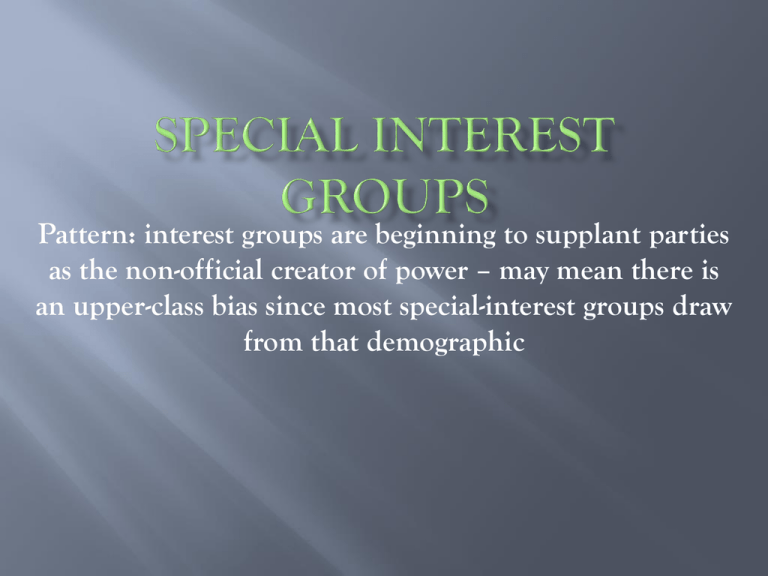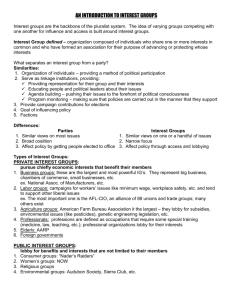Special Interest Groups
advertisement

Pattern: interest groups are beginning to supplant parties as the non-official creator of power – may mean there is an upper-class bias since most special-interest groups draw from that demographic What is an interest group? A group of individuals and organizations that share a common set of goals and have joined together in an effort to persuade the government to adopt policies that will help them Corporations (National Federation of Independent Businesses) professional lobbies (American Bar Association), labor groups (AFL-CIO, NEA) financial institutions (American Bankers Association) universities and the “research lobby” “public interest” groups (National Resources Defense Council) (Among the most feared: NRA, AARP,) Attract members (through their political goals, direct benefits like the AARP, NRA, or NEA, and/or social interaction) Financial structure (usually dues, contributions, or selling some ancillary services) Leadership and decision making structure & an agency that pursues the group’s goals through research, lobbying or public relations Educated upper-income management or professionals why? They have the education that gives them the skills, concerns and resources to participate Expansion of government (which is often encouraged by special interest groups) sparks the creation of even more groups in response Increased regulation of industry creates pro-industry groups that want to influence those decisions Court decisions on abortion and school prayer spark the creation of fundamentalist groups “New Politics” movement – spawned a variety of “public interest groups” Liberal professionals inspired by the anti-war and civil rights movements Common Cause, Sierra Club, NOW, Nader’s PIRGs Successful in courts and the media largely because their claims of being concerned with the “public interest” are largely unchallenged Grassroots conservative activity (fostered by conservative talk radio) Property rights activists, The Christian Coalition, National Federation of Independent Businesses, NRA, Family Resource Council -- Have had some success federally, but a real presence in state and local government Going public – creates a favorable climate of public opinion Can be constant Institutional advertising (the touch, the feel of cotton) Creates a positive association with the organization Boycotts, sit-ins, protests – Conservative groups boycott Disney because of perceived “prohomosexual” policies, Act-Up stages protests and sitins to try and increase funding of AIDS research Grassroots lobbying – people write, call their representatives Interest groups in recent years have spent nearly $1 billion on grassroots lobbying “Astroturf lobbying” – fake grassroots effort (letters are generated by PR firms and not by constituents) Lobbying- direct pressure on members of Congress through information, support or threats history of the term – term came in vogue to refer to a large anteroom near the House of Commons where members of parliament could be approached by people pleading their cases – in US term came about because people were meeting their reps outside the House and Senate chambers lobbyists are required to register under the Lobbying Disclosure Act which requires lobbyists to say who they are representing, who they are lobbying, what they are lobbying for and how much they are paid can act as an important source of information Forms of lobbyists: loyal members who know a lot about their field but not about Washington professional staff lobbyists for-hire lobbyists who are experienced in Washington – sometimes these lobbyists have served as Representatives, Senators, staffers or Cabinet members, the practice of hiring ex-officials to try and influence current officials is pejoratively known as “influence peddling” “cross lobbying” – lobbying another lobby to help them support or oppose something “reverse lobbying”- member of Congress try to raise support from lobby groups CONGRESS EXECUTIVE AGENCIES & INTEREST GROUP MILITARY-INDUSTRIAL COMPLEX (EISENHOWER-1961) Gaining Access- interest groups are actually involved in the decision-making process - Iron Triangle (such as the Military-Industrial Complex) - a mutual and self-supporting relationship develops between an executive branch program, a legislative committee, and an interest group (other examples may be in agriculture or education industries) once a law is passed a close relationship with the executive branch agency helps ensure its implementation (lobbying a bureaucratic agency is called “corridoring”) “the revolving door” is the tendency of former members of the federal bureaucracy to seek and receive employment from those industries they either regulated or purchased materials from Bring Suit Directly Financing Suits brought by individuals filing amicus briefs 1. 2. 3. Successful use of the courts women’s groups with Roe and Griswold Civil rights – brown v board Environmental groups 1973 – Endangered Species Act – includes a “citizen suite” provision that gives environmental groups ability to sue to challenge executive branch or private decisions that impact the environment Section 1983 of US code – establishes “fee shifting” if you win a suite against public officials then the government needs to pay court fees and attorney costs 1992 – Lujan v. Defenders of Wildlife – the “citizen’s suite” provision violates traditional rules on standing – if the court consistently rules that way it will be harder for environmental groups to sue Disability rights Groups 1990 – Americans with Disabilities Act – allowed for the physically or emotionally disabled to sue businesses, private organizations or local government agencies if their procedures or buildings deprived them of access, employment, or other opportunities – the legislation encouraged people to use litigation to secure new rights






